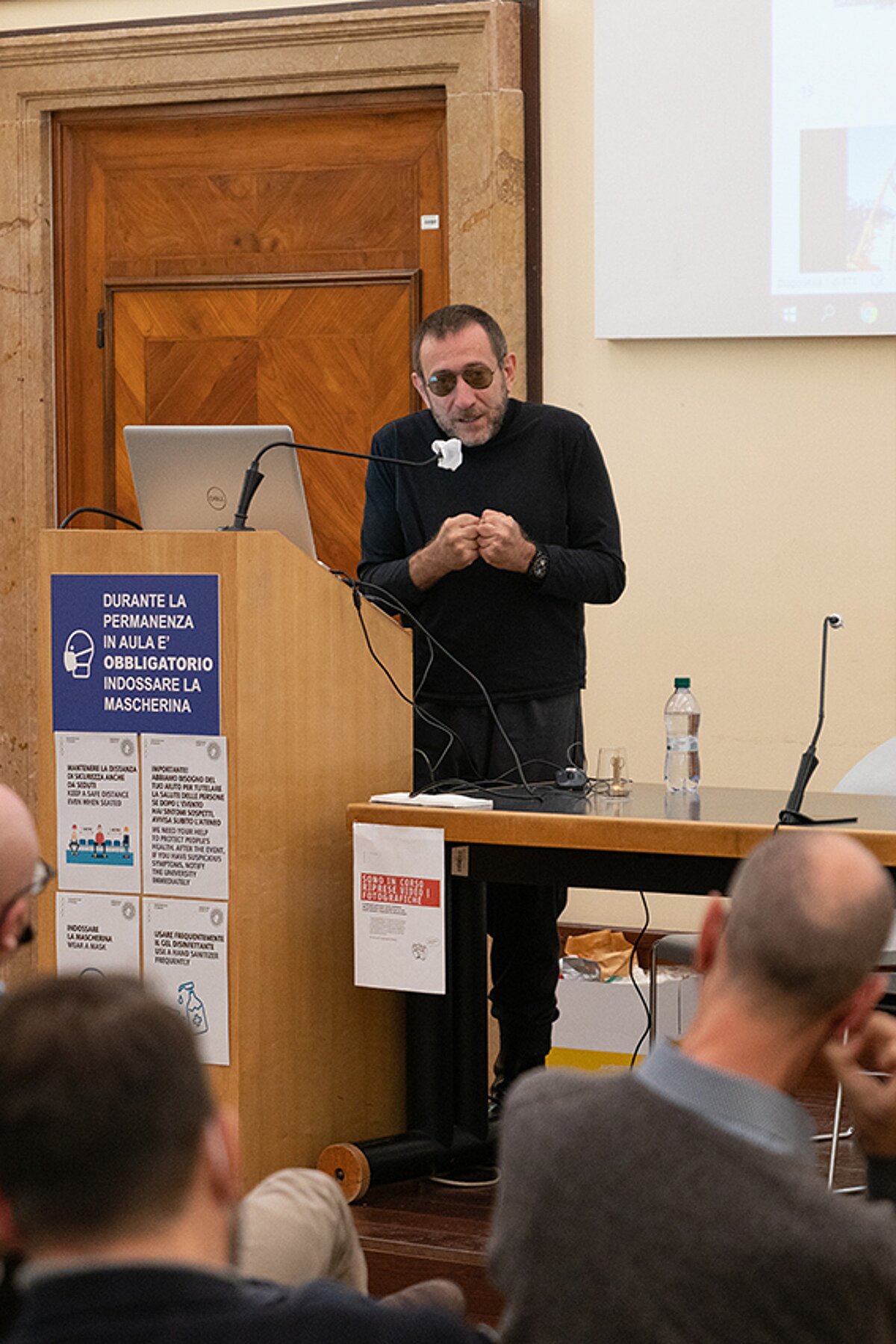NOVEMBER TALKS 2021: Bernard Khoury, Stitching the Skyline
After the online 2020 edition, due to the Covid 19 pandemic, the November Talks are back in presence at the Iuav University of Venice. The new cycle of lectures was opened by Lebanese architect Bernard Khoury. His voice and his works bear witness to the lacerations experienced by the people of the Middle East. This is also an important witness for the West because it represents 'a sort of foresight for our future [...] offering a sense of how to operate in emergency situations such as war, and more broadly in other emergency situations such as the energy crisis or climate change', according to Professor Fernanda De Maio, who introduced the conference.
Bernard Khoury grows up in Beirut during the civil war (1975-1990), then moves to the United States where he completes his studies, bringing with him various war "scars". In 1991 he graduated at School of Design in Rhode Island.
“Evolving Scars” (1991) is the title of his first works, which Khoury presents at November talks 2021. These are experimental, unrealised projects for the recovery of buildings destroyed by war, which are the starting point for his professional career, immediately characterised by a highly original and autobiographical trajectory under the influence of Lebbeus Woods.
Showing some of his selected projects, the architect describes the various stages of his work and life at the same time. Another season of his work is marked by the theme of the temporary aspect of his buildings, due to the uncertainty of Beirut's urban transformations and deformations caused by the tragic war situation. Therefore the B018 nightclub (1998) and the Centrale restaurant (2001) were designed to be temporary, but at the same time to be resistant to possible bomb attacks: the first one located in a complex neighbourhood, Karantina – the site of a terrible massacre of Palestinian Muslims in 1976 – is a subterranean nightclub, clearly recalls the military architecture of the Bunkers. The second one, with a stunning terrace under an openable roof, was constructed inside a bombed building during the civil war, whose many-scarred façades have been maintained by a consolidation structure wrapped in wire mesh. While the Central has over time been occupied by refugees, who have adapted it to residential needs, the B018, designed to last 5 years, has now lasted 23 years.
Temporaneity and permanence thus become the themes behind the next phase of his work, consisting of projects commissioned to be permanent, an assumption that is nevertheless difficult to maintain in a theatre of war such as Beirut. "I am an architect of the present, I can only think about the present" is how Khoury defines himself, overturning a thought, as well as an overconfidence, rooted and widespread in the design culture of the world, namely that the work realised can last even after the author's death.
Both in the excavated spaces as well as in the elevated buildings, Khoury's projects recall military architecture and the gears of war machines at all scales. This is a distinctive feature of his work that can also be found in the more visionary unrealised projects shown at the conference, such as Derailing Beirut (2010): an infrastructure consisting of a red railway track that crosses the entire city, like a large panoramic carousel that winds around significant points within the urban context, to which a transparent capsule is attached – a sort of missile –, designed to contain the human body and imagined as a machine for exceptional fruition of Beirut with a vertiginous view.
From the bunkers to the missiles, references that can be found in previous projects, to the fortified towers that can be recognised in Plot # 1072 - Skyline (2014), or the vessel evoked in Plot # 1282 (2017), Khoury hybridises his architecture, using a military repertoire that is sometimes direct, sometimes fantastic. This is not simply an identification code referring to an imaginary world strongly marked by war, but a necessity also imposed by the concrete need to defend buildings and people from war.
After the recent explosion in the port of Beirut, the tower building Plot # 1072 was damaged, deformed: 'it's like my baby didn't die but lost its skin,' says Khoury about it.
The explosion caused damage to the headquarters of his architectural office, as well as to himself who was injured, physically this time. So Khoury not only works on stitching the Skyline (Plot # 1072), through the study of a new skin/armour, but decides to offer his skills at the service of the community to repair and rebuild other buildings damaged by the explosion.
Khoury is an active opponent of the Lebanese diaspora, a war architect in every sense of the word, but clearly not for referring to the formal aspects of military architecture. Committed to the reconstruction of Beirut, he fights every day with tenacity to stay in his country.
Text by Daniela Ruggeri
You can download the high-resolution images here.
The follow-up reports, also from the other locations, will also be made available to you gradually. You will then find these data under the following link.
Watch our interview with Bernard Khoury on our YouTube channel.


